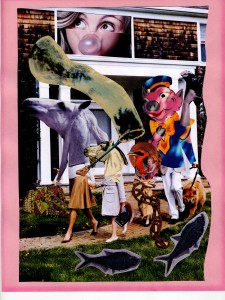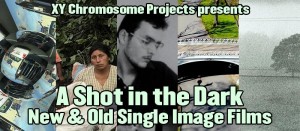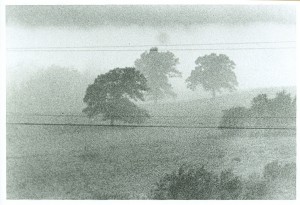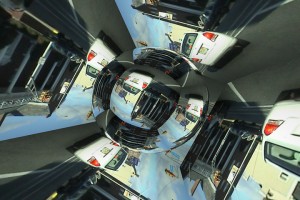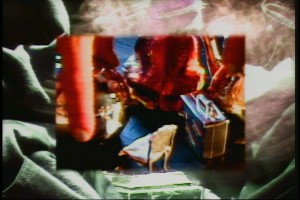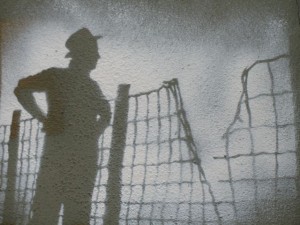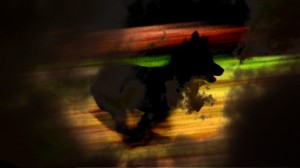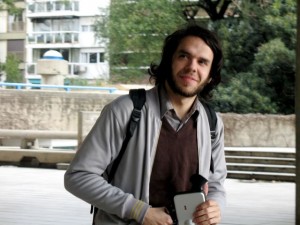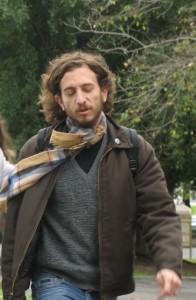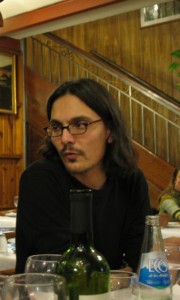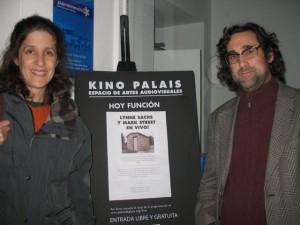Tag Archives: mark street
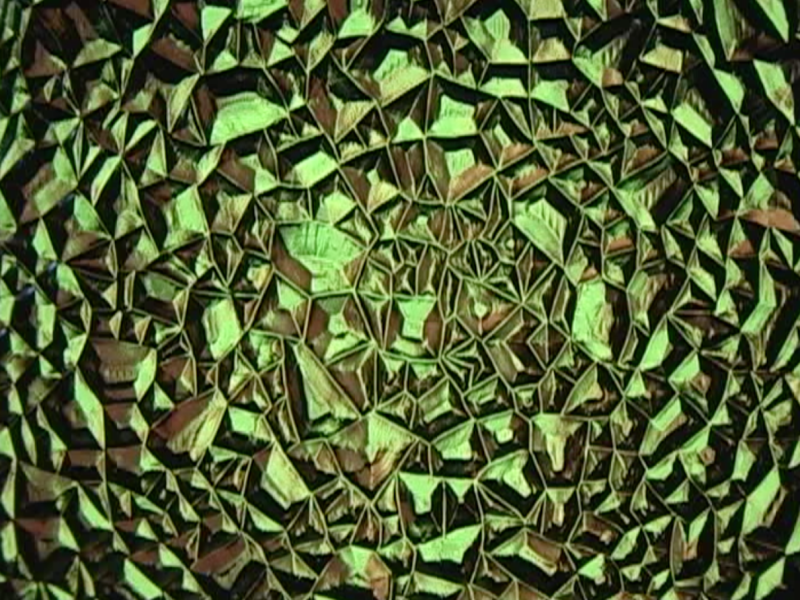
“At Home in the Night” – A Film by Lynne Sachs and Mark Street
December 2014
HI Oskar,
Thank you for all of your hard work on this amazing project!
Here is the corrected information you requested.
LYNNE SACHS-MARK STREET, At Home in the Darkness / USA / English text and dialogue / Dur: 4.14”
Text and dialogue:
00:00:07 Intertitle: We’ve always encouraged our daughters to walk on well-lit streets for safety.
00:00:14 Intertitle: But we also want them to embrace the dark.
00:00:22 Intertitle: Dad visits his museum of nocturnal artifacts.
00:00:26 Intertitle:The girls have better things to do.
00:00:31 Audio dialogue: All right Mr. Street. Now, I would like to ask you, what do you think you are going to do with this little movie?
00:02:06 Intertitle: Mom wants to go moon watching.
00:02:12 Intertitle: So the girls come along.
00:02:13 Audio dialogue:
what´s your idea of darkness or why did you choose this idea of darkness? – Can you tell her how to look too?
– Oh I see it!
– See the sort of cloudy area.
– See it right in the middle, but don’t look right in the middle. Look around.
– Oh yeah.
– They separate from the cloud.
00:02:51 Audio dialogue: Can we look? Girls do you want to see it? Maya! I will pick her up. See two stars? Wait.
00:03:07 Audio dialogue: Where do I look into?
THREE QUESTIONS FOR GENERAL INFORMATION, JUST ANSWER WITH A PAIR OF LINES PLEASE
- Where did you film your darkness?
New York City at the Fulton Fish Market; our backyard in Brooklyn; on the Gowanus Canal in Brooklyn; Brooklyn Heights, Brooklyn; Manhattan; and, Freshkills Park in Staten Island
- How was the shooting or let me know some details about it?
Mark Street carried a camera almost every day for a year, and this footage comes from that period. Part of it is shot through a corrugated filter purchased at an office supply store. Lynne spent a year trying to see and photograph the stars in the heart of New York City.
- What´s your idea of darkness or why did you choose this idea of darkness?
Mark: “I worked the night shift in a restaurant 30 years ago and it changed my life. Children are afraid of the dark, famously. Maybe learning to embrace the nightly shroud is all they need to know; to appreciate the mystery and subtlety of the sublime and primal.”
Lynne: “We take our daughters to places in the city that are dark enough to see a planet or a very bright star. We want them to appreciate the other worlds beyond our own. We hope they will always find their way when they feel apprehensive in the dark.”
Rabbis of the Round Table
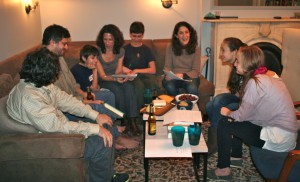
Mark Street, Jason Dubow, Karen Cuchel, Lynne Sachs, Ari Dubow, Isaac Dubow, Maya Street-Sachs, Noa Street-Sachs
Rabbis of the Round Table
a monthly Adult and Child Jewish Study Group
by Lynne Sachs
Posted on Kolot Chayeinu: a Progressive Jewish Community website: http://www.kolotchayeinu.org/home_practices#home
Back in 2004, I proposed to my husband Mark Street that I start a Torah study group for our half-Jewish-half-secular-humanist (the only unofficial faith or –ism he would embrace) 9 and 7 year-old daughters Maya and Noa Street-Sachs. He agreed reluctantly and skeptically, convinced that this passing fancy of mine for constructing a homemade form of religious learning would certainly go the way of Pilates or learning to cook. Having grown up as a Reform Jewish teenager in Memphis, Tennessee in the 1970s, I’d been introduced to the tenets of my family’s religion through a long, dreary series of Sunday school classes that successfully squashed any latent curiosity I might have had about our faith. It wasn’t until I passed the embarrassingly easy requirements for Confirmation at age 16 that I was given the choice to abandon my own spiritual edification or to continue in the lone, post-confirmation class for teens taught by a famously erudite local lawyer who conducted his class like a college literature seminar with a tinge of politics, European history and philosophy thrown in for good measure. Confident that this would be my absolute last chance to find even a thread of appreciation for Judaism, I signed up for Leo Bearman’s course and groggily drove my way to our synagogue every Sunday morning throughout my senior year of high school. To my surprise, the class was everything a learning experience could be – provocative, passionate, and rigorous.
And so with this profound moment in my young life still somehow resonating in my memory, I decided it would be possible to create a monthly study group for my own children here in Brooklyn in conjunction with our visits to Kolot Chayeinu for holidays, children’s events and the occasional Saturday service.
For the first few years of our de facto Havurah, we joined forces with another family with an eleven-year-old daughter. At each meeting, we would tackle a particularly dramatic and no-doubt famous story from the Torah. Quaint as it might sound, we called the group Bible Study and frankly that was what it was. Despite our unanimous opposition to the Old Testament as a significant doctrine of faith, we each believed that it was an intriguing, influential tome that would help our daughters better appreciate everything from the Sistine Chapel, to Creationism to 20th Century poetry. The Bible’s presence in our culture is pervasive and we wanted our children to understand its power, influence and resonance. Using The Children’s Illustrated Bible, we moved our way from the Garden of Eden, to Sarah’s pregnancy, to Joseph’s Coat, to Jacob’s dream, until after two years we completed the Old Testament chapters of the book. Because none of the children felt pressured to learn anything from one month to the next, they relished the humor and the drama in the stories, engaging in deep cross-generational discussions around such things as ethics, betrayal, commitment and sacrifice. Of course every one-hour Bible Study meeting finished off with a good meal, so the sensorial rewards were always within grasp.
Eventually our first collaborative family decided to move on, and so I was faced with the challenge of finding another family who was willing to commit one day a month to our old-fashioned endeavor. The second family who joined forces with us had an 11-year-old boy. Of course our children’s preteen enthusiasms waxed and waned but nevertheless we followed another two-year journey, this time referring to our monthly gathering in a more specifically Jewish way, Torah Study. Now with a more mature group of three students to teach, I met with Rabbi Lippmann for some guidance before embarking on Phase II. She suggested we acknowledge the sophistication of our own children by using W. G. Plaut’s renowned The Torah: A Modern Commentary as our primary text. Clearly the children were now ready to take the helm as teachers and Biblical provocateurs. As Jews do every fall, we started all over again with Genesis in September of 2008 with monthly readings and analyses of such stories as: Cain and Abel, The Flood, Babel, and Sodom and Gomorah. In our second year, we even began delving into Exodus. By this time, however, our children were no longer satisfied by a purest engagement with the literature. They demanded intense discussions around the meaning and existence of God, poignant debates about Palestinians and Jews in the Middle East and frank reflections on the role of women as depicted in this hallowed text.
In 2010, we embarked on Phase III of our study. It was a unanimous decision to put the bible to the side for a while and to engage with Judaism in a more creative and personal way. Together with our daughters (now 13 and 15) and a family with two boys ages 9 and 12, we created Rabbis of the Roundtable (named for the shape of our dining room tables). Each month we engage with some sort of reading that sparks a conversation. Our list of texts has included: “A Yom Kippor Scandel” by Sholem Aleeichem, “The Jewbird” Bernard Malamud; Maus by Art Speigelman, “The Boy in the Bubble” song by Paul Simon, “Conversion of the Jews” by Phllip Roth, “New York Filmmaker” by Ken Jacobs, “Address Unkown” by Katherine Kressman Taylor, “ Long to See My Mother in the Doorway” by Grace Paley, “The Plagues” by Moacyr Scliear, “King of the Jews” a film by Jay Rosenblatt, “World of our Fathers” by Irving Howe, The Boy in the Striped Pajamas by John Boyne, “Bontsha the Silent” by I.L. Peretz. Last month my daughter Maya was Rabbi so she decided that she wanted to take us out of the house to visit the permanent collection of Judaica at the Jewish Museum. Honestly, she had never even seen this collection before, so she researched some of the themes (both theoretical and religious) that had inspired the curators in order to lead us through the exhibit with issues to contemplate. As we gazed at the vitrines full of mazuzahs and menorahs as well as the more contemporary canvases on the walls, she asked us to ponder the artists’ intentions and the relationship of the objects to our sense of the visual in Jewish culture. Surrounded by these art works and artifacts, four adults and three children stood listening to Maya explore her own relationship to Judaism. I thought about the years we have spent in conversation about our shared culture and faith. It is not the answers we have found together that are so important but rather the questions we continue to confront.
Lynne Sachs
2012
XY Chromosome Project presents “A Shot in the Dark”
XY Chromosome Project
(Mark Street and Lynne Sachs)
presents
“A Shot in the Dark: New & Old Single-Image Films”
May 29, 2012 8 and 10 pm
Spectacle Cinema
124 South 3rd Street
Williamsburg, Brooklyn, NY
The XY Chromosome Project (Mark Street and Lynne Sachs) presents an
evening of eight single image films of no more than five minutes to be
premiered at the Spectacle Cinema along with the screening of two
classics of the same ilk, both avant-garde and political. Special
guest filmmaker Larry Gottheim will join us for the screening of his 1970
avant- garde tour de force.
Artists presenting new work include: Gregg Biermann, Su Friedrich,
Cary Kehayan, Kathrin McInnis, Meerkat Media, John Mhiripiri, Amos
Poe, Uzi Sabah, Kelly Spivey
with
“Fog Line” by Larry Gottheim (Gottheim will be present for the screening)
11 min. 1970 16mm (screened on film)
“It is a small but perfect film.” – Jonas Mekas
“The metaphor in FOG LINE is so delicately positioned that I find
myself receding in many directions to discover its source: The Raw and
the Cooked? Analytic vs. Synthetic? Town & Country? Ridiculous and
Sublime? One line is scarcely adequate to the bounty which hangs from
fog & line conjoined.” – Tony Conrad
and
Selective Service System by Warren Hack
13 min.1970
Since 1956, the United States had been involved in a ground war in
Asia. The American commitment had led to an ever increasing
involvement in that area of the world – despite growing
dissatisfaction here at home. To implement this country’s
mobilization, the draft system had been stepped up. This system made
virtually no exemptions for those who felt this war was immoral and
unjust. These young men either had to serve in a war in which they did
not believe, or face the bleak alternatives to service. Some chose
prison. Some sought refuge in other countries. This film documents
another alternative. There was no attempt to alter the proceedings
that took place.
Roundtable on Digital Experimental Cinema in October Magazine
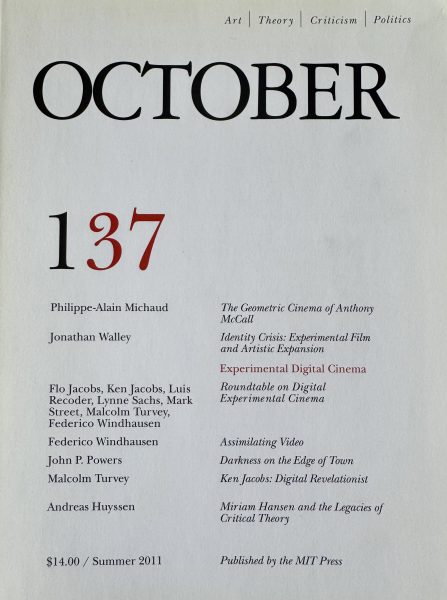
MIT Press Summer 2011
Roundtable on Digital Experimental Cinema
Ken and Flo Jacobs, Lynne Sachs, Mark Street, Luis Recoder, Federico Windhausen and Malcolm Turvey
www.mitpressjournals.org/doi/pdf/10.1162/OCTO_a_00057
Version Espanol: http://visionesmetaforicas.blogspot.com/2011/10/el-mes-de-october.html
Roundtable on Digital Experimental Cinema
Malcolm Turvey: We are here to discuss the various ways digital technologies have, and have not, impacted experimental filmmaking. There was a time, in the mid-1990s, if not before, when some people argued that digital technologies were revolutionary and that they would fundamentally change filmmaking. Now that the dust has settled, or at least started to settle, and we can look back over the last fifteen or twenty years, the “digital revolution” might not seem like a revolution at all. We want to talk about both what has stayed the same and what has changed in experimental filmmaking thanks to the advent of digital technologies.
Ken Jacobs: I think those people were right, but they were premature. They first made that argument about analogue video. But analogue video was not the way. There were people, like myself, who saw it as a great but transient medium. We saw good things being done, but now those things have gone.
Turvey: Are you talking about video art?
Ken Jacobs: Yes.
Federico Windhausen: When video art emerged, was it being discussed as something
that experimental filmmakers would have to address? I have always had the sense that experimental filmmakers in the era of analogue video art felt that they could keep their distance from it pretty easily.
Flo Jacobs: That’s because the film-developing labs were still functioning.
Windhausen: So it wasn’t a threat? It was something you could easily avoid?
Ken Jacobs: That’s right.
Windhausen: Do others recall the situation in the same way?
Mark Street: I remember the discussion about who was a video artist and who was a filmmaker, and how they had different purviews. You said the advent of analogue video art—so you’re talking about the early 1960s?
Windhausen: The moment of wider dissemination of the technology in the late 1960s and ’70s.
Street: In the 1980s, when I went to film school, there was still that distinction, but it started to mean less. People were making choices about shooting on analogue video based on economics, not based on content or aesthetics. When I first went to film school, people would ask, “Is it a film, or is it a videotape?” But ten years later, it didn’t seem to matter as much.
Windhausen: Were you around when Canyon resisted distributing on video?
Street: Well, some at Canyon resisted and some didn’t. There were some who felt that video was a threat, as you say, and there were younger people who felt that it really didn’t matter what medium was being used, that what mattered was the work itself. I remember being pulled both ways.
Flo Jacobs: Don’t you think the change really occurred when cheaper editing soft- ware like Final Cut Pro became readily available? Before that, there was Avid, but Avid was expensive. Then Final Cut Pro changed everything.
Turvey: When was that, Flo?
Flo Jacobs: 1999.
Windhausen: Right around the time that cheap digital cameras came on the market.
Lynne Sachs: I think that was a revolution in terms of access. Because of its accessibility, more people could enjoy the freedom of using the new media for creative thinking. People started to believe you could be a “filmmaker” with- out being a “director,” and that making a film could be an autonomous act from start to finish, as painting and writing are. That was very radical, because before that, there was a hierarchy in filmmaking (except among experimental filmmakers who tried to work outside that hierarchy). I think there has been a very important shift in society’s understanding of filmmaking. People realize that the resources are there to do it individually. This “democratization” is not just a political shift; it’s a paradigmatic shift in that it allows filmmaking to be the product of a truly individual vision, as Stan Brakhage and others always advocated.
Windhausen: But hadn’t the Bolex 16mm film camera already enabled a lot of what you’re talking about? It facilitated a shift from thinking about becoming a director within the industry to thinking about oneself as a creative artist working individually outside the industry. The difference in the digital era is that there’s already a long history of experimental filmmaking, and that history has valorized and legitimized the notion of the individual film artist that you are talking about, whereas when the Bolex emerged, people like Maya Deren in the 1940s had to stake their claim to being a film artist.
Street: There’s another history at work too, and that’s the history of video art, which is a half step toward what you are talking about. Because analogue video was a popular, anti-high-art medium, it spoke to the idea that you could own your own camera and respond to television and things like that.
Ken Jacobs: The first video cameras were pricey—they weren’t that inviting. I remember one thing that shocked me was their low resolution. Ralph Hocking ran a video center, a lab upstate, and in his own work he consciously exploited video’s “low-res” rather than imitating film.
Sachs: The shame of the digital world is that as the machinery gets more and more advanced, there is an attempt to mirror reality as closely as possible. That is what I think is so disturbing, whereas the avant-garde is not trying to mirror reality. We’re trying to shape, investigate, play with, and sculpt it. High-definition is so unappealing to me because of that.
Luis Recoder: You used the word “sculpt,” and I think that film is becoming more of an art because of these crises. The digital wants to emulate film, and it is in a crisis: it doesn’t have a history. While that is going on, filmmakers like myself can work with film in a way that maybe you weren’t able to at one time. It’s a different kind of a possibility, I think.
Turvey: Do you mean that digital technologies show filmmakers ways to use celluloid that they might not have thought of before, ways that emphasize film’s differences from high-definition digital video?
Recoder: Yes, filmmakers and projection artists can work with celluloid in ways that are highlighted and assisted by this crisis, rather than evading or negating it.
Sachs: What do you mean by “crisis”?
Recoder: Well, you were saying that you’re not crazy about high-definition, right? I’m not crazy about it either. For instance, when you go to a film festival and bring your video, you don’t know what it’s going to look like when it’s projected, whereas with film, you have a better idea of what it’s going to look like and you can work with the projectionist to get it right. Video artists can sometimes do the same thing. They can run tests to see the quality of the projection. But often, you take your video to Sundance, or international film festivals, and it’s a bummer when you see it projected. With the medium of film, you have more control. I mean, you can even bring your own projector!
Ken Jacobs: I disagree. I can’t imagine a level of control over film that compares to the control you have with video.
Flo Jacobs: Except that you had fantastic problems switching over to PAL and Progressive Scan. You had disasters.
Ken Jacobs: Yes, there were problems. But let’s not forget the computer. It is this fantastic brain that can do anything. It gives just incredible freedom and control.
Sachs: For a while, one was totally dependent upon institutions in the city to con- vert from NTSC to PAL. But these days I can do much better conversions using Final Cut Pro and some other compressors than they can do. It takes a little while, but it looks perfect, going from PAL to NTSC or the other way.
Windhausen: But you’re talking about the advantages of video in production and postproduction, while Luis was talking about control over projection enabled by film.
Ken Jacobs: But there is a forward momentum with digital video, an urgency that’s lacking with film, which is just dying. There are only two film-processing labs in the city now. These problems with video will cease to be problems after a while. Video is constantly improving.
Flo Jacobs: But the other problem with digital video is preservation. What’s going to happen in ten years?
Ken Jacobs: The labs tell us that the only way to preserve digital video is to put it on film—on 35mm. [Laughter.]
Sachs: There are also the changes in our thinking brought about by these new technologies. The practical changes they occasion are a big part of our daily lives. But the changes in our thinking are harder to grasp. The other day, I was watching experimental documentaries by students from Union Docs, and I asked them a question about sound, and every single student had downloaded their sound from the Internet. For them, it wasn’t about listening, about the surprise of finding something in the world around you. Instead, they seem to want to work in a cleaner comfort zone. Of course, we all work with found footage, and I adore that. But the surprises that come from working in the field teach you something about who you are in the world. I asked these people, who are all in their early-to-mid-twenties, if they ever go out into the world to listen to and record sounds. Their answer was no, for the most part. For them, filmmaking is more about acquiring the world than engaging with it.
Windhausen: Mark, do you find this with your students?
Street: I can make an analogy with books. I was talking to a student the other day and I said: “You’re looking for a book and it’s in the intellectual vicinity of these other books, so you go to the library to look for the book, and if the book isn’t there, there might be other books close by that could be of interest.” But it was an alien concept to this student—the idea of wandering and browsing and letting the library take you where it will. Nowadays there really is a more acquisitional approach to sound and images. It’s more like “I’m looking for this; let me go and get it” rather than “I’m going out to shoot and maybe I’ll happen on something by chance.” I think that’s a weakness of the digital age.
Ken Jacobs: They live only in their own times. They are not listening to the world, just making something out of the computer.
Turvey: Hold on. Isn’t it possible to discover something by chance on the Internet as well?
Sachs: That’s what they said to me. They said, “We find the most amazing things on the Internet,” and I said, “Oh, I spend plenty of time on the Internet, I know!” But they think: why go listen to the birds if you can download all these bird sounds without even knowing which birds they are?
Turvey: Lynne and Mark, if I understand your work correctly, you use multiple for- mats to shoot on, right? Do you do so because each medium offers different possibilities or advantages?
Street: For me, yes. I was in the basement today looking at a 16mm print that Craig Baldwin sent to me. I had to go downstairs and thread up the projector just to look at it, and there are limitations involved in that, just as there are limitations involved in shooting 16mm and Super 8mm film. I try to let those limitations speak, while also enjoying the freedom of the digital age. These days I transfer everything to digital, so I feel I can go out and shoot a roll of film and it’s OK to be defined by that roll for two minutes and forty seconds. But then I transfer it to digital and that opens up other possibilities.
Ken Jacobs: What moves you to still shoot film? Street: I like the texture of it; I like the fact that when you shoot a roll of film, it becomes a specific entity and it’s unlike any other thing. It has its own weight and characteristics. You know? Thirty-six exposures: a roll of still film becomes like a little narrative, a little vignette of sorts. And I think that’s useful. I remember when I first started shooting videotape, I would fall asleep looking at my footage. [Laughter.] There was so much of it. I had six hours of footage. It used to be I had two rolls! You’d made it work, you’d make it count. So I like those limitations, I like being hemmed in, because making work is always about overcoming the obstacles.
Turvey: You are also interested in 35mm film, right? That’s fairly unusual within the experimental-film world. Didn’t you use 35mm film trailers in Trailer Trash [2009]? Where does that come from, that attraction to 35mm?
Street: Well, for a very brief and misguided period of time, I thought I could circumvent the fact that 16mm was disappearing in the early 1990s. I made a film called Sliding Off the Edge of the World [2000] in 35mm in the hope that I could maintain the purity, such as it is, of the filmgoing experience. I was motivated, in part, by the experience of trying to show my films on 16mm. I would pay for a 16mm print and spend a lot of time and money figuring it out, only to be asked: “What’s that?” or, “Don’t you have that on tape?” Or to be told: “The projectionist is not here.” So I made a few 35mm films, and as I worked at a lab, it was easy for me to do that. However, Trailer Trash was finished in mini-DV, and I don’t really have any desire to work in 35mm anymore.
Windhausen: Ken, you did a couple of found-footage films on 35mm as well, right? Is it Disorient Express [1996] or Georgetown Loop [1996] that’s available on 35mm?
Ken Jacobs: Both are.
Windhausen: For the size of the image, because they are widescreen?
Ken Jacobs: That’s right. I hear what you’re saying about the intensity of using film. It costs so much, the meter is always running, and I honor that. But I enjoy having too much stuff on video, and then looking through it and seeing what unexpected thing I find, something I just couldn’t plan.
Turvey: So you find the extra volume of material facilitates creativity and surprise?
Ken Jacobs: I look at that stuff the way you might look at the world with a film camera. You pick it up from the world, but I’m looking at this already-recorded stuff to see what’s there that can suddenly be made vital.
Turvey: Luis, if I understand your projection process, you use 16mm film exclusively, is that right?
Recoder: And 35mm.
Turvey: You are from the youngest generation of filmmakers in this room, and so that means you would have gone to school in the 1990s, would that be right?
Recoder: Yeah, mid-’90s.
Turvey: Can you say something about why you work with celluloid film?
Recoder: I think it has a lot to do with what Lynne said earlier about the availability of media. Digital made celluloid film more available. You can now find it in a flea market for really cheap. I entered filmmaking at that moment in the mid-to-late-’90s when the hierarchy between celluloid film and digital wasn’t there. I didn’t have that kind of baggage, the view that one medium is more authentic than the other. It was more about availability and economic factors. Working with a projector and found footage, by chance I became a projectionist. I was going to festivals and was invited into the booth to set up my projector, and I learned about projection that way. I discovered possibilities within the realms of the theater and the booth, and the division between what’s hidden and what’s not, the apparatus and the audience. So it was really a schooling through the rear end of cinema, through the projection booth, which happened by chance. It wasn’t that I wanted to make films; it was more that I was led into it.
Windhausen: Guy Sherwin says that as well—that you can now buy film projectors really cheap. For him, digital has made it easier to work in film projection and performance than it was before, because you can just go on eBay and buy all these cast-aside film projectors that nobody wants anymore. Luis, you’ve been appearing at what I assume are expanded-cinema festivals. Have you seen other artists at these festivals working in video in ways that run parallel to, or in interesting contrast with, what you do in film?
Recoder: Not as much, but there are a few people working with old analogue video equipment from the ’70s, so there is a revival, a backwards gaze at the medium of video itself. I think it’s because it’s so hands-on. Even in music there is a revival of the old analogue hands-on process. It’s all due to performance, the desire to perform with the medium. Earlier, I used the word “control,” but really I think it’s an improvisational process. There’s control in the sense that you know what different things are going to do, but then the performance opens that up into messier, less controlled ways of working with
the material.
Windhausen: So in your experience of going to these festivals, there has been a revival of expanded cinema largely in the photochemical-film and analogue-video modes, but not so much in the digital-video mode?
Recoder: I haven’t really seen digital video, but I’m sure it exists, more so in the art world than in the film world. At film festivals—not just at expanded-cinema events but also traditional film festivals—they are opening up spaces for installation art and performance, and my partner Sandra Gibson and I fall into that niche. A lot of festivals, even big ones like Sundance, want to highlight materiality. In a strange way they are becoming “structural materialists,” albeit unconsciously. They invite us because they want materiality, again due to the crisis occasioned by digital media. With digital media, there is nothing material to see or touch as a medium.
Sachs: I think one of the interesting directions that the digital world is taking us toward is a fetishism of decay. We miss decay, so we have to create the activity of something physical breaking apart or aging. In the world of architecture they create furniture that looks faux-worn and antique. It is very peculiar to me that there are digital effects that can create scratches and dust. We don’t want things to age. Nevertheless, we miss the chemical reactions, the fact that physical things change, so we simulate decay. It’s so strange. The desire for decay is a nostalgia for the aura of the original and its physical transformation. In digital, the original isn’t transformed, but we want it to be. I don’t necessarily aspire to this myself, but then I find myself including things like the flash-out flames, and I use found footage because it adds a texture that gives me so much delight. I think it does the same for the audience, who say, “Oh, I really like that,” because it doesn’t look realistic, it doesn’t look like television or digital video. That’s why there’s a desire for decay.
Windhausen: But it’s also a desire for the material markers of the filmstrip, as in the simulated end-of-roll light flares you now see in those spots for the Sundance channel. Things that experimental filmmakers first discovered about film or liked to reveal to an audience are now so easy to achieve digitally.
Street: But isn’t it a nostalgia on the part of the younger generation for something that never existed? The great “experimental” filmmaker Francis Ford Coppola said that he has no hankering for film. He lived it, but his daughter who didn’t live it, Sophia Coppola, wants to shoot on film all the time. I used to have this idea that you could go out and get projectors, Dumpster-dive, buy stuff on eBay, etc., and create a DIY punk film aesthetic. Then a student brought in an old camera, a regular 8mm camera, and it was rigged in a weird way with a funny magazine, like a regular 8mm magazine that you would pop in. I had never seen anything like it, so we poked around on the Internet and discovered you could buy those magazines through a Web site. There was a guy in L.A. who was tinkering with and remaking them and then selling them for $70 or $80 each. I realized there was something faux-nostalgic about this. It wasn’t about finding the detritus of the culture and using it. Rather, it was about re-creating it, in an anachronistic way, like wearing a pince-nez or jodhpurs or something like that.
Turvey: So decay and obsolescence have become commodified and clichéd? Street: That’s how I felt, that people are paying too much for these things. Why not just use a video camera that’s cheap and that’s the lingua franca now, you know?
Ken Jacobs: But the marks of these older technologies mean something. They ring a bell, they do something. I studied decay, OK? My Tom, Tom, The Piper’s Son [1969–71] is really about decay, among a lot of other things. It wasn’t about nostalgia, it was about asking, What is this old stuff? What is it made of? What is its character as a series of light impressions?
Windhausen: There is a video by the artist Cory Arcangel called Personal Film [2008], which is full of the effects you are talk- ing about, but he made it on a desktop digital imaging pro- gram and had it transferred to 16mm film. It has flame-outs and scratches and count-down leader, and when you look at it in the installation space—it was at Team Gallery a couple of years ago—it’s a 16mm projector projecting a 16mm film. If you don’t read the text about it, then you don’t know that it was all done on a digital desktop. For better or for worse, he’s someone whose work reflects how that younger generation works with digital imagery.
Ken Jacobs: But that’s to make nonsense out of this stuff. The flameouts—I kept them in my films for a number of reasons. I wanted to say, “This is the end; I can’t shoot anymore, because I have no other roll of film.” But I also wanted to say, “This is film; this is the character of film. What I’m showing you are unedited rolls from a camera; I left the flash frames in”—that was part of the statement. And now you can make it happen digitally, and it doesn’t connote anything. It doesn’t signify. It’s just an effect.
Sachs: That’s why I think that the flash-frame only exists as a conceit, as a metaphor. It’s no longer indicative of something material.
Windhausen: Luis, you choose not to show your audience what you’re doing in terms of the photochemical film processes and the projection processes that you’re working with. What’s your sense of how they understand the images that you’re creating, given the lack of knowledge about photochemical film that we’ve been talking about. Do you care?
Recoder: Yeah, I do. When I started doing projector performances, a lot of the peo- ple who came to see the show were let down because there was no performance in the traditional sense. I wasn’t in front of the screen doing things. Nowadays, when you are talking about expanded-cinema shows, that’s what they expect—there are a lot of younger artists putting projectors in front of the audience and in front of the screen, so that you can see what they’re doing and can see the effects of what they’re doing. I try to work with Ken Jacobs. Celestial Subway Lines. 2004. the audience’s anticipation of this kind of performance and their subsequent disappointment, where the whole spectacle maintains itself as an illusion and then breaks down. The audience is confused about what they’re really seeing and what’s really happening. Is it film? Is it video? I work within the space of that confusion.
Windhausen: But does what you’re doing remain, then, a mystery for the audience?
Recoder: Slightly. We reveal it sometimes afterwards, during the Q&A.
Windhausen: Ken, at times you have shown audiences what you’re doing and at times you deliberately hide, or stand in front of, the apparatus.
Ken Jacobs: That’s only with the Nervous Magic Lantern. I don’t want people to think that they understand it because they see its parts. It is completely mystifying to me, doing it, and I don’t want an easy answer for them.
Windhausen: Do you care whether they think they see a film performance or a video performance? Some of my students get it wrong if they don’t see the apparatus.
Ken Jacobs: No, I do care. I don’t want them to think that they’ve seen video, although I’m not consistent. We were in Paris, and the interest in seeing the machinery was so strong, I just opened it up. I want people to realize that it really is a magic lantern. That’s all it is. The result is coming from these primitive means. To have someone think it’s video would be disappointing. Now, some of it is being recorded on video. There is a DVD of a piece I did with John Zorn, Celestial Subway Lines/Salvaging Noise [2004], so I guess I don’t think that it’s always so important that one see the machine. I also want the effects onscreen to be appreciated for themselves.
Flo Jacobs: But you can’t record it at all; it’s impossible. Every time we rehearse, it’s different, no matter what you do.
Ken Jacobs: What Flo is saying is that each time I do it, I improvise. I can’t repeat what I did a previous time.
Street: I’m just wondering: if flash-frames are film ephemera and Joan Jonas’s verti- cal roll is early video ephemera, what are the ephemera for digital video? What do people show when they’re showing us the subconscious of the medium?
Windhausen: Ken shows artifacting, pixelation . . .
Street: Ernie Gehr shows the space between the frames, as in Crystal Palace [2002]. I guess that’s it.
Windhausen: What we’re talking about are the medium-specific gestures that are typically made when a medium emerges and artists want to see what are, for example, the unique artifacts of decay within that medium, or something like that, right?
Street: Right, things that remain particular and idiosyncratic to that medium.
Windhausen: Cameras these days are like computers in that they have built-in obsolescence, like laptops. After a certain number of years, a camera is going to be off the market and obsolete. You and Lynne still work with mini-DV rather than HD, so you’re already old-school. Ken, meanwhile, has moved on to high-definition (he’s the youngest of all of us). [Laughter.] Last year Ken had a Creative Vado High Definition handheld pocket camera, and now he’s already got a new one that I’ve never even seen before. It doesn’t even have a viewfinder or a screen! So the question becomes: why bother doing medium-
specific work when your medium is obsolete within a year?
Ken Jacobs: Young people, I believe, are sampling. They encounter something, they get an idea, and then they go for something else. The idea of making a discrete work that begins here and ends there is passé.
Windhausen: At the Oberhausen Film Festival’s retrospective of his work this year, Fred Worden said something similar when discussing his newer work in video. Filmmakers can now continually revise their work, because they have it on a hard drive. You just look up a particular file and continue working on it. The open work is becoming more of a norm now.
Street: I think that openness is good. I always encourage my students—this is Final Cut Pro talk—to create a new sequence every time they sit down to edit, as if they are reinventing the film every time. Filmmaking was linear; it involved a progression. As you edited it, the film hopefully got better, shorter, clearer. But in the digital age, you can sit down on a Tuesday and reinvent your film and on a Wednesday reinvent it again; you are not bound by a linear progression.
Windhausen: You don’t have the point of termination of having to pay for the print, for example.
Street: There was also an investment in every one of your gestures. A splice had bet- ter be good, because it was costly to go back. But with digital, you can experiment and play around because nothing is irrevocable. Very few of my students take me up on that, though. It’s usually still one sequence that they invest in and keep trying to improve.
Sachs: There is a term used today, which is “non-destructive.” The way we work now is that everything is protected. You’re never really working with what you did yesterday but rather with a duplicate of it, so that if you don’t like what you do today you can always go back to what you did yesterday. But when you were editing with film, you didn’t have that freedom. You were working with a work print, and if you cut it, of course you could put it back together, but most of the time, if you did intricate cutting, you were going towards some- thing and you weren’t going to break up all those little frames again. It was essentially destructive; there was no return. But now we want the constant capability of returning to something as if we were striving towards perfection and any risk we take might lead us astray from that perfect end.
Ken Jacobs: Are you saying this is positive or negative?
Sachs: I don’t know. It’s positive because I’m used to it now, but I don’t know if it makes me more risk-averse or less.
Turvey: So if it’s so easy to alter and go back, how do you know when a film is finished? What is the criterion, now, for a finished film?
Ken Jacobs: Oh, wait a minute. That’s nothing new. One simply senses that it is done, just like with a painting or a poem or anything else. You step away and it’s done. I don’t think that’s changed. I want to say this: Kino’s Avant-Garde 3 DVD contains Danse Macabre [Dudley Murphy, 1922], The Petrified Dog [Sidney Peterson, 1948], Plague Summer [Chester Kessler, 1951], The Death of a Stag [Dimitri Kirsanoff, 1951], Image in the Snow [Willard Maas, 1952]—all of these could have been shot on video. There are very few films that pertain to the twenty-four frames per second, or sixteen frames per second, of the film strand. It takes some of Brakhage’s work, or Kubelka’s, to say, “Yeah, that had to be shot on film.”
Windhausen: What about Wavelength [Michael Snow, 1967]?
Ken Jacobs: Wavelength could have been shot on video, too.
Windhausen: Snow might say that you go from a long shot to the close-up of the postcard with the waves, which is a pyramid-shaped trajectory, whereas the projection from the film projector to the screen forms an inverse pyramid.
Street: But doesn’t that concern projection rather than being shot on video? There is the distinction between showing something on a small screen versus a large screen, and the distinction between shooting something on film and video. For example, I saw Jeanne Dielman, 23 Quai du Commerce, 1080 Bruxelles [Chantal Akerman, 1975] at Film Forum, and I had only seen it on VHS on the small screen. When you see it big, it all comes together, and when you see it small, it’s nothing. It’s a question of kind not degree.
Ken Jacobs: Scale is enormously important. It’s the same thing with music. Scale is significant.
Windhausen: Interesting. So what you’re saying is that for a large number of experimental films, there is not much lost if you watch them on video?
Ken Jacobs: No, I am saying that there is nothing lost if you make them on video;
there is if you watch them on a monitor.
Windhausen: Oh, OK. Now, related to this and to distribution issues, there seem to be more festivals showing experimental work now than ever before. So do you find that your work is being disseminated more than ever before? To what degree are the festivals more important or more prominent than exhi- bition venues like Anthology Film Archives? Also, none of you have films on the Web. None of you have Web sites where full, high-definition versions of your work can be seen. Why not?
Ken Jacobs: I’m unhappy when things are shown in less than optimum conditions. It makes me very unhappy, and that’s why it’s really important to make hard copies. Hard copies exist when people really care about work, people who want to have a DVD or something.
Windhausen: And is more of your work being seen, not just at festivals but in venues that are interested in showing works by Mark Street or Ken Jacobs, now that they can find a DVD to rent?
Ken Jacobs: Yeah, and they can find us.
Windhausen: OK, so how many of you travel with your work? One of the core values of experimental film is the temporary community of the theatrical audience, the people in the seats who are watching your film. If film exhibition becomes Web-based, you lose that temporary community, potentially. Is that something that you are reluctant to let go of? Do you care?
Street: I’m reluctant. When you’re in your house, you’re surrounded by the things that you love, that you bought—bourgeois trappings—and I think you’re less able to take risks. But when you go sit in a theater, there’s a social contract. I’m watching Jeanne Dielman, I’m bored, but I’m not going to get up. I’m going to stick it out because there’s a social contract and I’m part of the temporary community you mention. I have a film festival at the end of every semester with my students, and the students ask, “Why? Why do we all have to get together at 7 p.m. on a Thursday? Can’t I just look at a disc, can’t you just give me a disc? Is it going to be on the Web?” It’s a very telling, contemporary question.
Ken Jacobs: And when they look at a disc, they skip through the film, the fuckers. [Laughter.]
Street: I like the social part of it. I think it’s important to be in the same room with the work and experience it as a group in the dark.
Ken Jacobs: I disagree. It’s always just me and the work. I’m not even with Flo when I’m watching this thing. I’m with the person who conceived and presented it, just like reading a book. I’m alone. I don’t want people around.
Sachs: You asked about whether we travel with our work. I actually make a lot of effort to travel with my work, and it’s extremely disruptive to family life and work life. But it’s very important to me. It keeps it alive. It makes it human. Many times I am paid an honorarium but they say, “We want you to be here,” and it’s not very much money. Nevertheless, I do my best to go with the films if I can. It’s worth it to me to feel that aliveness the way musicians do, or theater people. It’s not as if my work is all over the place in stores and it has this productive presence in society.
Windhausen: I can imagine younger filmmakers thinking that Web distribution is fine because they will get feedback from blog comments or things like that. But I haven’t seen it. I still find that younger filmmakers want a body of people responding directly to their work.
Ken Jacobs: I would very much love for my stuff to be available. Free is OK with me, although every so often I realize that’s not realistic. We need the money, there should be some money coming back, but really I just want the work simply out there, and as good as it can be.
Flo Jacobs: What Ken really wants is to travel with live works, otherwise it doesn’t make any sense. It’s easy for him to just put a DVD in the mail, so the only reason to travel is to perform.
Street: For you, Luis, the DVD does not exist, right? Recoder: No, we have DVDs. We like to have our work seen by as many people as possible, and not everyone can invite us, not everyone has those resources. Our work has been shown on DVDs in installations, at places where they couldn’t invite us to go and do performances. For me, the medium of digital video is irrelevant; it’s just another distribution format. What we do is not video art. Some people might see it that way, but that’s not really a direction that I’m interested in.
Ken Jacobs: I’m someone who really likes working with accidents, and to me, video is a vast accident, you know, unplanned, unexpected, wow!
Turvey: Can you give examples?
Ken Jacobs: Well, I work with these miniature digital cameras, and I can’t see through them. For years I worked without a reflex lens, and it was a major thing in my life when I could afford to buy one with a built-in viewer. These miniature digital cameras are cheap models, unbelievable models. They focus by themselves, they get the right light levels by themselves. You press a button to turn them on and another to take a picture. Yes, there is a lot they don’t do, but it’s so much fun exploring what they can do, much of which is unexpected. So, I’m really grateful.
Turvey: Ken, would you ever go back to shooting on film? Ken Jacobs: I’m not inclined to. Before I worked in digital video, I had pretty much stopped filming. One reason is that I had accumulated so much footage and I just didn’t want to add to the number of unfinished works. They were very hard to finish; I never had the money. Flo Rounds a Corner [1999] was the first video I did, but it made finishing Star Spangled to Death [1957–2004] as a video thinkable. Forty years, or something like that, after I started it on film, I was able to finish it as a video, and I’m so grateful.
Windhausen: You were talking earlier, Mark, about medium-specific gestures like the vertical roll, and I was thinking of work like Paul Sharits’s from the ’70s, which was accompanied by Sharits’s theoretical statements, which would undergird, or run parallel to, the work he was doing. In the digital era, while there are academics who theorize about digital media, it doesn’t seem to be the case that experimental filmmakers are taking that step. As they move into digital, they don’t appear to be writing theoretical texts about the properties, possibilities, or capacities of the medium, or making work that says, “Maybe digital is this.” Instead, they seem to be working intuitively with the materials, and the theoretical stuff is left largely to academics.
Street: It’s interesting to put it that way. I wonder if it’s because every- thing seems possible in the digital world, so filmmakers don’t feel the need to highlight the limitations in the way that they did with film.
Ken Jacobs: It takes an exquisitely disturbed person to dwell on what they can’t do. [Laughter.]
Street: I think it’s interesting, the idea of theories or manifestos about the properties of a medium. Think of Fred Camper’s “The Trouble with Video” [1985] and the update. I don’t agree with him, but it’s interesting that he compared film and analogue video. I don’t know that any filmmaker is doing that with digital. It’s too easy, in the digital world, to think that the latest thing is the new language and is not to be questioned. I see that right now with the 16:9 aspect ratio, for instance. It used to be that we had 4:3 or 16:9, that there was a choice. But in the last two years, I’ve noticed with my students that it’s not a choice any- more. They use 16:9, and that’s it.
Windhausen: So can we agree that the filmmakers here are relatively conservative in that they prefer to show their work in a theatrical projection situation where the temporary community of an audience has to watch the work from beginning to end?
Ken Jacobs: And you can’t go to the bathroom! [Laughter.]
Windhausen: That’s fairly conservative though, right?
Flo Jacobs: No, it isn’t! That’s not conservative.
Windhausen: It is today. You’re conserving it as a tradition. It’s a valuable tradition but it’s a conservative move.
Flo Jacobs: Do you want to walk in to the middle of Strangers on a Train [Alfred Hitchcock, 1951]? I don’t think so. Is that being conservative?
Windhausen: I guess I mean new work.
Recoder: I think you can be more radically conservative now in the gallery. There are things that we are doing, my partner and I, that no theater is going to show. They are too long, or too boring, whereas in the gallery you can show them.
Windhausen: You’re making gallery work now?
Recoder: Yes.
Windhausen: But you’re in the minority here, is what I’m saying.
Ken Jacobs: All of us make work that begins at one time and ends at another time. We want it to be seen that way!
Sachs: I do have a piece on the Internet called Abecedarium: NYC [2009], and every time that I open it, aspects of it are different. It will speak back to me based on the climate, on how the public
participates.
Flo Jacobs: In terms of being conservative, I think the work has to be seen from beginning to end. You can’t just stroll in, visit it, and stroll out. You can say the same thing about a painting. You wouldn’t want somebody to cut a detail out of a painting at the Met and hang that up, would you?
Windhausen: Well, there’s a difference between a perpetually open work and one that’s finished. I’m thinking, as a point of comparison, of new-media artists, who make work that’s interactive and continually open to change. It can be entered into and left behind at any point.
Flo Jacobs: But that’s their concept, that’s their work. Windhausen: Another shift is that television is more cinematic, now, in every way, and people emulate the film theater in their homes.
Ken Jacobs: That’s good, because what about the kids who are looking at a cluttered monitor while watching a movie in bed?
Sachs: Or three movies!
Windhausen: “What’s wrong with that?” the kids would say.
Ken Jacobs: That’s right, they would say that. But they would not understand the problem.
Sachs: That is a real function of the digital, the fact that people believe that it is just as good an experience to watch more than one thing at once.
Ken Jacobs: Multitasking.
Sachs: Or multi-watching. It’s not even a task, because they’re not having to do something. It’s a “more is better” attitude.
Windhausen: In relation to this, I was thinking, Luis, that what I’ve seen at expanded-cinema festivals is a lot of work that is ambient, where I have the sense that the artist expects you to dip in and out of it in a relatively aleatory and arbitrary way, whereas what I’m accustomed to in single-screen theatrical, experimental films is having my attention be directed from beginning to end.
Ken Jacobs: OK, there was this guy named Andy Warhol [Laughter], and he intro- duced “background paintings” to convivial meetings, with people drinking and talking in front of something that looked expensive. That is a huge tradition now. I call it “stuntism”—fifty paintings of Marilyn Monroe or whatever. It’s not about asking people to learn how to see and to look at something very intently.
Turvey: But there are different kinds of work, right? So, obviously, your work demands and requires an intense perceptual engagement. But that’s not true of other kinds of work, or some television shows, or other things that one might consume on a smaller screen.
Ken Jacobs: There are households where the TV is the first thing on and the last thing off.
Turvey: What I mean is that there are different viewing modes appropriate to differ- ent kinds of work. Just because people are watching three things at the same time on small screens doesn’t mean they are watching them inappropriately. For example, it would be foolish to sit and watch a CNN broadcast with the perceptual intensity that one would watch a work you make. Ken Jacobs: Yes, I think we are what they call fascists. We want to dominate your complete attention.
Recoder: I think that’s what you were asking about, Federico, the aleatory, “in and out” perceptual experience of a certain kind of performance. Allowing that sort of open play and knowing that you have audiences who have all kinds of attention spans is to be anti-fascist, I think. And when you take out narrative and images, you are completely lost. One of the things that brought me to the avant-garde was the experience of viewing. I felt that I could walk in and walk out of it, not physically but perceptually. It allowed me to be in a space where there is a confusion between “Am I making this? Or is this making me?”
Windhausen: But you are articulating something very different from what these three filmmakers do in their single-screen works. Maybe you’re an exception, Ken, but most of the work that you’ve all made has a beginning, middle, and end, and you place a value on directing the viewer through the work. But with expanded-cinema pieces, as Luis has said, it’s the viewer making the work in an aleatory process that is equal to or of more value than being directed through the workaround.
Ken Jacobs: I don’t direct anybody. I am fascinated, and if I remain fascinated from beginning to end, that’s all the direction that goes into it.
Street: But Federico, there was ambient work that you dipped into and out of in the ’50s and ’60s. I don’t know that it’s technological.
Windhausen: It wasn’t the dominant mode. I’m talking about dominant modes within experimental cinema.
Street: So you think the dominant mode of experimental cinema today is aleatory?
Windhausen: No, I think it’s the dominant mode of expanded cinema.
Street: Right, but I think that’s a style, and I don’t think it’s any greater today than it was in 1969, or 1959, even.
Windhausen: Well, it’s certainly more popular today than it was back then.
Street: Maybe, but there has always been artwork that is non-directive, that allows people to engage it with various degrees of attention. It would be interesting to compare this new paradigm, as you describe it, to Christmas on Earth [Barbara Rubin, 1963], or something.
Windhausen: I’m not saying that those precedents don’t exist; I’m just saying that they weren’t as prominent as they are now.
Recoder: I’m interested in the word Federico used, “conservative.” I’m wondering where that’s coming from, as if you were trying to pin us all down.
Windhausen: I was talking about the theatrical situation with the temporary community and everyone looking at the same screen at the same time. That’s a long-standing value within the tradition of experimental film, one that I hope continues. But it is “conservative” from the perspective of the new-media artist.
Street: I’m conservative in that sense. I’ll sign.
Experimental TV Center presents Sachs & Street at Anthology Film Archives
In 2001 and 2003, I traveled to Owego, New York for a one-week residency at the ever-so-inspiring Experimental TV Center, a funky brick loft in a small upstate village where artists have been living and making video work for forty years. While there, I created images for my films Investigation of a Flame, Window Work and much later XY Chromosome Project, a collaboration with my partner Mark Street.
TRIBUTE TO THE EXPERIMENTAL TELEVISION CENTER
An evening showcasing the amazing video art created at ETC over the decades from 1970-2007.
Friday, July 15th – 7:30pm
Anthology Film Archives, 32 Second Avenue New York, NY 10003
The Experimental Television Center is a unique video art production studio in Owego, NY. Since its founding in 1971, ETC has been providing artists with access to the tools of video art production through residencies and grants. The studio includes several one of a kind pieces of video processing equipment including a custom-built Dave Jones Colorizer and 8 Channel Video Sequencer, the Paik/Abe Raster Synthesizer or ‘Wobbulator’ and a custom Dan Sandin Image Processor, among others. This month, after over 40 years of service in the media arts field, directors Ralph Hocking and Sherry Miller Hocking are retiring and closing the Center down. The Standby Program’s has selected this program of videos from 1971 to 2007 that were preserved through their ETC Preservation Program.
Program :
XY Chromosome, Lynne Sachs & Mark Street, 2007, 12:00 min.
An impressionistic odyssey for the eyes becomes both haunting and delightful in this moving image dream expedition.
“Sachs and Street engage in visual and aural dialogue to explore the spaces between abstraction and representation. Street’s inexhaustibly tactile images use handpainted found footage and camera-less films like luminous palimpsests before the eyes. Sachs responds with theatrical, microcosmic worlds where the everyday is defamiliarized through hundreds of trembling and resonating objects.” (Flavorpill.com)
with:
We Can’t Go Home Again, Nicholas Ray, 1970-72, 4:00 min. (excerpt)
Earth Pulse, Gary Hill, 1975, 5:35
etc, etc, Caspar Stracke, 2005, 6:08
Lake Affect, Jason Livingston, 2007, 1:13
Delta Visions, Shalom Gorewitz, 1980, 5:02
Bug-Eyed Ramrod, Matt Schlanger, 1984, 5:48
Transmigration, Julie Harrison & Carol Parkinson, 1987-89, 10:15 (excerpt)
Gender Rolls, Connie Coleman & Alan Powell, 1987, 3:21
Godzilla Hey!, Megan Roberts & Raymond Ghirardo, 1988, 2:20
Dirt Site, Alex Hahn, 1990, 15:53
Wax or the discovery of television among the bees, David Blair, 1991, 13:33 (excerpt)
Red M&Ms, Bianca Bob Miller, 1988, 3:51
An Argentine excursion: film frames, talk therapy, and ice cream
An Argentine excursion: film frames, talk therapy, and ice cream
by Mark Street and Lynne Sachs (with Pablo Marin)
Published in Otherzine Feb. 2011
http://www.othercinema.com/otherzine/?issueid=25&article_id=129
In 2008, we packed our bags, got on a plane and moved to Buenos Aires for two months, studying Spanish as a family (with our two preteen daughters), shooting film and diving even deeper into the experimental film scene. We learned to speak Argentine Spanish (the “y” sound is pronounced “j”, so “Yo” becomes “Jo” and “pollo” become “pojo”), eat dinner late and spend hours sobremesa (at table) chatting and sipping wine into the night. This land can make you busy New Yorkers feel impatient and shallow, as the Argentine filmmakers we met seemed to relish spending time discussing their movies as well as the political issues of the day (multiple agricultural protests) in Europeanist distended style. Maybe it comes from the Argentine their obsession with psychoanalysis, but talk is not considered passé in Argentina.here.
Our apartment was near the Museo d’Arte Latino Buenos Aires (MALBA) where we relished the best modern art collection in town, as well as a full film schedule. We saw a Hugo Fregonese retrospective, as well as the hilarious campy ¨Esperando la Carroza¨ by Juan Carlos Lenardi which friends had recommended. What a way to learnas a way to learn Spanish, through the movies. It’s like Imagine learning English by watching “The Rocky Horror Picture Show.”
A lynchpin of the scene is the urbane and witty Ruben Guzman. A prolific filmmaker and programmer, Ruben had moved to Canada in the 80’s but recently returned to make work and program in Buenos Aires. The Kino Palais at the Palais de Glace shows 4 nights a week in a cavern-like space in the back of the museum. It’s an underground club hidden in a 19th century ice skating rink (no kidding). This is where we presented our X-Y Chromosome Project , a subjective take on global warming, to the Buenos Aires community for three nights, the same program we presented at Other Cinema, slightly adapted to a Spanish-speaking audience. Here’s what they saw:
“From archival snips of an educational film on the weather to cine poems in full blossom, New York film ‘avant-gardeners” Mark Street and Lynne Sachs present the XY CHROMOSOME PROJECT .This program of 10 short films on both single and double screen gleans audio-visual crops from the dust of the filmmakers’ fertile and fallow imaginations. In this avalanche of visual ruminations on nature’s topsy-turvy shakeup of our lives, Street and Sachs ponder a city child’s tentative excavation of the urban forest, winter wheat, and the great American deluge of the 21st Century (so far).”
Over Peruvian dinner, Ruben introduced us to Federico Windhausen, an Argentine-American media arts historian currently living in Oakland and teaching at the California College of the Arts. Windhausen is a man whose Argentine roots run deep. He is the best informal cultural guide we’ve ever encountered, anywhere, constantly suggesting film screenings, theatre and dance pieces (in the plaza of the Biblioteca Nacional, for instance) and ice cream (helado) places. The Argentine obsession with ice cream is legendary. Ice cream is a legendary obsession with Argentines. Once at an asado (barbecue) in the countrysuburbs, the conversation wound its way from politics to movies to children’s attributes with nary a raised voiceconflict. When it came time to ordering helados though however, the guests argued vehemently and passionately in defense of their favorite flavors.
Whenever we found the conversation turning to the subject of Argentine experimental film there was one name that never failed to come up: Narcisa Hirsch. Over the last forty years, this grand dame of South American cinema has earned a well deserved reputation for making extraordinary films that are both formally rigorous and deeply personal. Inspired by the feminists and the Fluxus artists she met and worked with in Europe in the 1960s and ‘70’s (including renowned artist Carolee Schneemann), Narcisa brought back her profound appreciation for North American avant-garde film to the artists’ community she knew and loved in Buenos Aires. In the company of her good friend Ruben and Paula Felix-Didier, the director of the Museo de Cine, Lynne spent was fortunate to spend a fascinating afternoon with Narcisa in her home-studio discussing her forty year filmmaking career, her children and grandchildren and her farm in Bariloche, in the south of Argentina.
Pablo Marin is one of the guiding forces of experimental cinema in Buenos Aires, and his blog La Region Central (title taken from the Michael Snow film) is an amazing living document. (http://laregioncentral.blogspot.com/)
Once Pablo and we (sans Lynne) spent the hour just before dusk shooting 16mm film around some stands that sell meat and sausages right next to the Reserva Ecologica. Later Mark and hewe drank beers in a café on the Avenida Corrientes (sort of the psychic artery of the city). Mark asked him to give a quick historical overview of the past.
“The early Argentine experimental period is represented by just a bunch of separate films, made by filmmakers that didn’t pursue a total exploration of the medium and, most importantly, didn’t think in terms of a community or movement. Horacio Coppola, a leading name in Argentinian still photography, made a few films during the 1920s and ‘30s. His most important is “Traum”, a 16mm film that reminds me of the French-German Surrealists.
“Víctor Iturralde and Luis Bras were a couple of pioneers of experimental animation in the ‘50s and ‘60s. They mostly painted and scratched on celluloid films in 35mm, 16mm and Super 8mm.
“The 1970s and 80s were a strong and vital period for experimental film in Argentina. An actual alternative film community was born. During the 70s, we experienced a military coup d’etat which resulted in little contact with the experimental film world abroad. Our productions were more scarce and individualized. Many films were made (mostly all in 8mm and Super 8) but the conditions of exhibition were totally underground and unconnected (garages, houses, etc). All this began to change in the early 80s when Buenos Aires’ Goethe Institute began showcasing as well as protecting these films and filmmakers. Under the Goethe’s umbrella (to put it visually), this kind of film practice could grow without fear of persecution (that’s why the government reaction was never that intense) and with more support for the movement collectively. The highest point of this Goethe period (if one could call it that) was in 1980, when the Institute held a workshop of experimental film with German filmmaker Werner Nekes. In this period many artists were working, such as Claudio Caldini (Super 8, Single 8), Narcisa Hirsch (16mm, Super 8) and Jorge Honik (Super 8). Other names include Juan Villola, Horacio Vallereggio, Marie Louise Alemann, Juan José Mugni and Silvestre Byrón. The films where shown in bigger, more social, environments but the reaction of the audience was mostly hostile. Once at a screening of Caldini’s “Gamelan” the audience started booing and shouting and turning off and on the lights ! It is also important to note that in this period these filmmakers were more in touch with international, experimental film production. To name a few screenings, there’ was Jonas Mekas’ 1962 screening of “Guns of the Trees” at Mar del Plata Film Fest and in 1965 the Di Tella Art Institut screened a bunch of New American films (Mekas, Brakhage, Warhol, etc.). Besides that, Narcisa Hirsch traveled a lot to buy film prints that even today represent the most important private, experimental film archive in Buenos Aires.
“Since 1990, experimental media has for the most part switched drastically towards video even though makers such as Caldini and Hirsch continue to produce films. The opening of several film schools makes experimental film more accessible and more studied. The public screenings of international works have gained a solid following mainly through Buenos Aires Independent Film Festival and Mar del Plata, and it is also more common to see screenings of local experimental works at these venues. Some of the important names are: Andres Denegri, Gustavo Galuppo, Gabriela Golder, Ruben Guzman (all in video), Daniela Cugliandolo (Super 8, video) and Sergio Subero (Super 8, video).”
With this backdrop for experimental film all around us, we tried to let ourselves become charged as artists inwith the poetry Buenos Aires, too, and move ahead with our own work. Mark shot 16mm film and videotape attempting to capture the idiosyncrasy of the city, following up on his film “Hidden in Plain Sight” (a city symphony film shot in Dakar, Hanoi, Marseille and Santiago de Chile). He became obsessed with the cartonieres, the gleaners who sift through trash to sell cardboard on the outskirts of town, and the portreros, the men who sit behind glass windows at middle class apartment buildings watching and waiting. He is currently editing the project, tentatively titled “Fans of Argentina”(based on the store displays that feature industrial fans running at different speeds, like enormous film shutters).
While making her most recent film, “Wind in Our Hair” (Con Viento en el Pelo), Lynne worked with With Argentine super 8 filmmakers Leandro Listorti, Pablo Marin and Tomas Dota., Lynne shot “Wind in Our Hair” is , an experimental narrative inspired by Julio Cortazar’s short story “Final del Juego” about four girls (our daughters Maya and Noa and their two Argentine friends Lena and Chiara Peroni) who stand by a passing train everyday posing like “sculptures and attitudes.” The film is very much about longing, the rite of passage between childhood and adulthood, and performance of an inner self. The crew of cinema friends shot with a real potpourri of formats – from obsolete Kodak Regular 8 to Super 8mm, 16mm and video. Our daughters Maya and Noa and their two Argentine friends Lena and Chiara Peroni were hopping on and off trains throughout the summer as part of the production. The film used the entire city as a set – including the Tigre Train line that sweeps through the Parque Palermo, the majestic Retiro train station, the flea market in San Telmo’s Plaza Dorrego, and a quiet backyard on the outskirts of the city. “Wind in Our Hair” film had its Bay Area premiere at Other Cinema in April of 2010.
Our last day in Buenos Aires we walked a few blocks to a huge multiplex and caught Lucretia Martel’s brandnew “La Mujer Sin Cabeza” while our kids took in a dubbed version of “Mamma Mia” at the screen next door. As we munched a last alfajore walking back to the apartment to collect our security deposit we came up with the idea of curating a film screening in NYC upon our return.
Six months later, on February 21, 2009, we showed thirteen Super 8, video and 35mm films from Argentina at Anthology Film Archives in New York City. In curating “Ventana al Sur: An Evening of Argentine Experimental Film” we culled films from a whole array of non-traditional works made over the last 3 decades, some by veteran masters and mistresses (Leandro Katz, Liliana Porter and Narcisa Hirsch) and some by young upstarts and renegades (Pablo Marin, Ruben Guzman, Macarena Gagliardi, Sergio Subero, Leandro Listordi, Ernesto Baca) with newfound passions for the moving image. Here are descriptions of just a few of the works we showed:
Leandro Katz’s “Los Angeles” (5 min., 16mm, 1976) is a portrait of a small community living by the railroad tracks in the banana plantation region of Quiriguá, Guatemala. Originally a single take, this film alternates equal number of moving frames and frozen frames as the camera tracks alongside the train station.
Narcisa Hirsch’s “Workshop” (10 min.,16mm 1977) is a structuralist vision. One wall of the filmmaker’s studio as seen through a fixed camera. We see photos she’s stuck on the wall, then there is a dialogue with a male friend to whom she is describing the rest of the walls that you don’t see. A “one upmanship” of a similar film by Michael Snow where he describes a wall of his studio- workshop, by describing what one CAN see.
“Bajo Tierra” (4 1/2 min., Super 8, sound on CD, 2007) is Pablo Marin’s portrait of filmmaker Claudio Caldini who makes a new cinematic offering in front of the no-longer-industrialized Kodachrome.
In “Montevideo” (4 minutes, DVD, 2008) Leandro Listorti looks at the capital of Uruguay reveals, briefly, its characteristic of a Doppelgänger City: a single place cut in two spaces where two pairs of creatures explore the limits of the travelogue.
In “Stock” (5 minutes, 2007, mini DV ) Ruben Guzman follows a boy from La Cruz who walks to school to read aloud the stock market report from the newspaper. We are witness to the last day of capitalism.
Ernesto Baca’s “Nunca Fuimos Allah Luna” (7 min., 35mm, 2008) presents two characters on split screens, conversing and arguing as the city unspools kinetically behind them.
The show was packed with Argentine expats, curiosity seekers, and hard core experimentalists who wanted to see how subversive cinematic effusions looked from the land where summer is winter and winter is summer. Since we had some of our first and best film dates at Other Cinema in the early 1990s when we were denizens of the Mission District, we tried to recreate that kind of informal, bon vivant celebration of the senses and the screen here in downtown Manhattan. We served yerba mate from communal gourds at the show—there’s no caffeine in mate, but there is something in there, and the room seemed to float on the wings of a filmic reverie. We also served sweet dessert churros (filled with dulce de leche of course) purchased at the famous Buenos Aires Bakery in Queens. In 2009, we presente this program at the Pacific Film Archive along with an excerpt Federico Windhausen’s “When the Pueblo Was Hollywood”.
On our way home to Brooklyn, we played back images from the screen in our heads—the frantic single frame pace of Narcisa Hirsch’s “Aleph”, the wry and witty animated vignettes of Liliana Porter’s “Para Usted/For You” and the truncated urban space of Pablo Marin’s “Sin Titulo”, shot on an apartment building roof in Buenos Aires. As distinctive as New York is, it also recalls other cities, in a similar way that Buenos Aires can seem like Paris or Madrid, refracted, if you squint your eyes just right. As revelers ducked in and out of bars at 11 pm, it felt as if an Argentine night was just beginning.
In 2009, the Pacific Film Archive presented out “Ventana al Sur” program in Berkeley along with an excerpt from Federico Windhausen’s “When the Pueblo Was Hollywood”, a film he shot in the north of Argentina. Lucky for us and the Bay Area audience, Windhausen was able to be there for the show to field questions on Argentina Cinema, a topic on which he, like us, is passionate.

